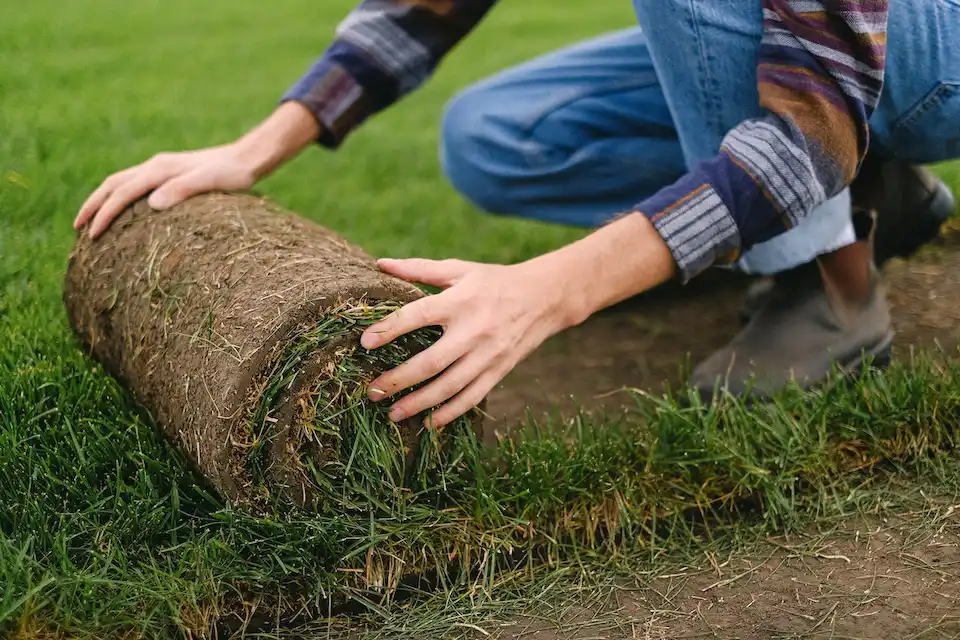
Considering Laying Sod In The Winter?
When it comes to landscaping, some rules are universal. However, when it comes to the best time of year to lay sod, the first step to knowing when to start sod installation is to understand the climate where you live. Grass-growing systems are affected by freezing temperatures vs. warmer ground temperatures, which makes some grasses ideal to plant in the winter season, whereas others should be planted in spring or fall.
Homeowners in Southeastern states like North Carolina are often surprised to learn that laying sod in winter is one of the best ways to prepare your lawn for spring. Our Wake Forest sod installation experts at FortSmith Landscaping are sharing the pros and cons of laying sod in the winter, as well as our tips for how to complete the process to achieve the ideal green lawn for spring and summer.
Benefits of Installing Sod During the Winter
The primary benefit of installing sod in the winter is that you get a head start in spring establishment, giving your new root system time to grow and “green up.” In other words, while your neighbors wait for spring to roll around before laying sod pieces to cover up bare ground patches, you are ahead of the game thanks to winter sod installation. Your turf will already be thriving come springtime.
Take it from us as a lawn care company serving the greater Wake Forest and Raleigh, NC areas: having the professionals come to install sod in the winter is a great time to avoid busy booking schedules and inventory sell-outs or wait times. You can get ahead of other homeowners by booking our lawn care services early to install your new sod.
Advantages of Planting Dormant Grasses in the Colder Season
We often look at the time of dormancy as not very useful, but dormant sodding in winter allows the grass to grow slowly while not needing a lot of care like regular watering or fertilization. This makes for a stronger deep root system that encourages a healthy lawn for spring but does not take a lot of effort on your part as the homeowner.
Understanding Types of Grass and Their Cold-Weather Hardiness
Choosing the right grass types for winter installation is the key to your off-season sodding. Not all grass types can hold up to colder temperatures, while other grass types will make for a green winter lawn.
There are over 12,000 species of grass, but not every grass can stand up to the harsh, cold temps for winter sodding. Understanding the best grass for cold season newly laid sod is the only way your dormant grass will become thick and lush when temperatures warm.

Cool-Season Grasses vs Warm-Season Grasses
North Carolina has the benefit of experiencing a variety of seasons and weather patterns, making ours a state where both cool-season and warm-season grasses can grow and thrive. Cool-season grasses grow best in the fall and still remain green in the winter, whereas warm-season grasses take longer to green up in spring and go dormant after the first frost of the season.
Identifying Turf Varieties That Thrive in Winter Conditions
What grass varieties are best for residents in mixed climates like North Carolina? Which sod laid in winter conditions will thrive?
Best warm-season sod to lay in winter:
- Zoysia grass
- Bermuda grass
- Centipede grass
Best cool-season sod to lay in winter:
- Kentucky bluegrass
- Tall fescue sod
- Annual rye seed
Preparing Your Soil and Site for Laying Sod
If you are looking to buy sod but are unsure of the best kind for your yard, contact a sod installation contractor with knowledge of the local climate for recommendations.
Measure your lawn area so you know the amount of sod needed in square footage.
In order to prepare your soil for laying new sod, it’s important to first remove dead sod from your lawn. Next, your lawn should be lightly tilled at a depth of 4-6 inches. Make sure there are no branches, rocks, or other debris where you plan to lay the new sod.
Conduct a soil test to see if your soil’s pH is acidic or alkaline, then adjust with amendments such as treating it to incorporate lime or sulfur depending on the soil test results.
Laying the Sod During the Winter Months
When beginning to lay sod, you’ve already ensured the area is clean and leveled, with the soil having been tilled and broken up. Begin laying your new sod in a brick wall pattern, ensuring you lay sod pieces tightly together. Following the rule that when you get to a hill or slope, the sod laid in a perpendicular pattern helps to prevent soil erosion.
Apply herbicides, weed killers, or other treatments. Additionally, a good starter fertilizer applied to the new sod will promote healthy growth.
Once all your sod is laid, using a lawn roller filled with water, roll over the sod grid in a back-and-forth pattern, watering the freshly laid sod with the lawn care equipment. Sod rollers can be rented from local lawn care stores that sell or rent other lawn care equipment, or you can have your sod installation done by a trusting and professional Wake Forest, NC landscaping company.
As long as your new sod is watered and rolled properly, your lawn should not be susceptible to freezing temperatures that may arise in the late winter months.
Selecting the Right Time to Install Dormant Sod
Sometimes it just isn’t possible to install sod in the late summer or early fall months, so choosing winter, between late March through early May to install dormant sod for a home, golf course, or athletic field will allow the newly laid sod to cover bare ground, reducing soil erosion or other factors that could impede its health and growth.
Maintenance of Newly Installed Sod in Wintertime
It’s important to stay aware of the winter temperatures and how much water your new lawn is receiving throughout the winter months when your new sod bed will remain dormant. Making sure you have adequate irrigation that is not adding excessive water to your lawn and damage its root system is important throughout the dormant months.
Contact FortSmith Landscaping To Talk If Now Is The Right Time To Lay Sod For Your Yard
Do you need to get rid of a poorly rooted lawn? Are you looking to bring the vibrancy of a plush, green lawn to your yard for the spring and summer? It’s time to schedule a consultation with a professional lawn care and sodding expert to evaluate your lawn needs and schedule an action plan.
FortSmith Landscaping can lay sod in the winter so that it thrives when the warm weather arrives.
Contact us today by calling (919) 228-8495 or filling out our contact form.
